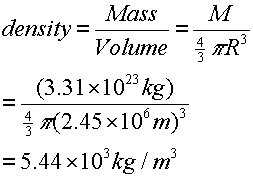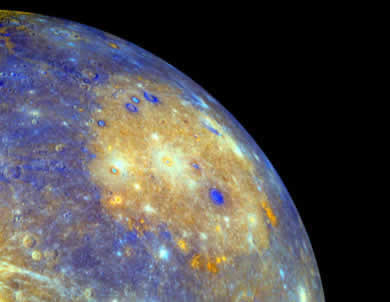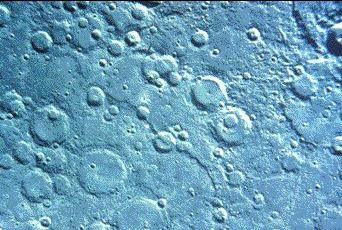Mercury
483 - 488
Mercury is named after the fleet-footed "Messenger of the gods" and for good reason. It is the swiftest of the planets with an orbital period of 88 days. Its proximity to the Sun makes it a hot and lifeless world that in many ways resembles the Moon.
Basic Facts
|
 |
|||||||||||
| Figure 17.20 Image from the NASA Messenger spacecraft. (Iimage courtesy NASA) |
Mercury is a difficult planet to observe and only those who make a special effort have seen the planet even though it is very bright. The problem, of course is that Mercury is always situate close to the sun in either the evening or morning sky and is usually lost in the glare of the sun. At one time ancient astronomers thought that Mercury was two different planets. Telescopic observations reveal an essentially featureless disk.
Example 17.8 Even though Mercury shares many similarities with the Moon use the mass and radius data from Table 17.4 to argue that Mercury must be fundamentally quite different than the Moon.
| Solution: Calculate the average density of Mercury. As shown on the right, Mercury's average desnity is much higher than the Moon's. This suggests that they are very different objects and may have formed quite differently. |  |
Orbital Resonance
Mercury exhibits an orbital phenomenon that we will encounter with the asteroids and Jovian planets. The orbital period of Mercury is 87.97 days which is 1.5 (3/2) times the rotational period of 58.65 days. The very low rotation rate is a puzzle but the fact that it is precisely 2/3 the period of the planet is very important. This is called rotational resonance or spin-orbit coupling and results from the concentration of mass on one side of the planet. As the planet approaches the sun the gravitational tidal tug ensures that either the heavy side is directly towards or directly away from the sun at perihelion (closest approach)
| Figure 7.22 |
You might wonder why the rotation of Mercury is not tidally locked the same way that the Moon's rotation is locked with its orbit around Earth. The reason is subtle and is because Mercury travels on a highly elliptic orbit. This means it is travelling much faster when it is a perihelion (closest to the Sun) than when it is at Aphelion. If the planet was turning at the same rate as it is orbitting when at preihelion then it would be spinning too fast when at aphelion. The 3:2 resonance is the "best it can do"!
Mercury's Landscape, Structure and Composition
Mercury has, in all probability, an extensive and hot core consisting of heavy elements (Fe, Ni, Co). Recent flyby missions (Mariner 10) reveal that despite the slow rotation rate Mercury has a magnetic field. This supports the suggestion that Mercury's core is very large. The surface is essentially mantle material made up of silicates.
 |
 |
| Figure 17.23a Caloris Basin as imaged by the Messenger spacecraft July 2008 (Image Courtesy NASA) | Figure 17.23b Weird terrain on Mercury at a point opposite the impact site for Caloris Basin (Image Courtesy NASA) |
Surface analysis reveals that like the moon, Mercury has experienced intense asteroidal impacts and extensive lava flow activity in its history and continues to be struck by meteoritic material.The Caloris Basin area of the planet is the result of a particularly violent impact that - by seismic focusing - produced a very distinctive and jumbled region on the opposite side of the planet. Planetologists - at a loss for a better term - call this a weird landscape! This is shown in Figure 17.23a,b and in Figure 17.24. Seismic focusing is the result of p-waves traveling through the planetary interior and being focussed onto a region diametrically opposite the original impact site. |
 |
| Figure 17.24 Sesimic focusing causing weird terrain on side of Mercury opposite Caloris Basin impact site. |
Another peculiar feature of the Mercurial landscape and shown iun Figure 17.25 are the lobate scarps (curved cliff-like structures) that are believed to have formed as the planet cooled and shrunk slightly.
| Figure 17.25 is a roll-over image that shows two scarps. |  |
| Figure 17.25 Roll-over image showing two scarps on surace of Mercury. |
Practice
- Zero orbital inclination means it is possible for Mercury to have ice caps! Explain why this is so.
- True or False (and explain!): The 3:2 resonance in Mercury's orbit is a result of tidal interaction with the Sun.
- Explain what a 3:2 orbit resonance is. Suppose Mercury had a 5:2 orbital resonance - what would its rotation rate have to be for that to occur?
- In what sense does Mercury have an atmosphere?
- What is seismic focusing?

To understand Mercury within the framework of the SNT
Chp 21-2
![]()